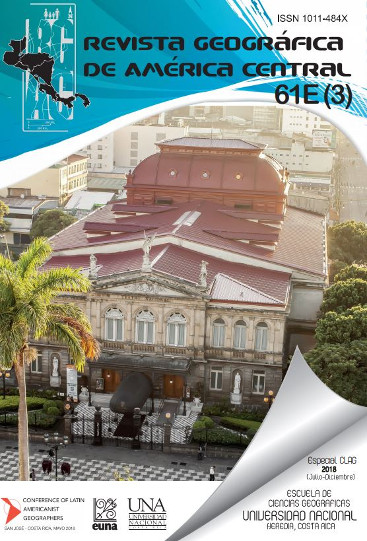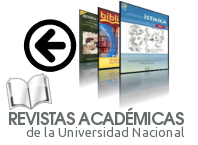Unit’s productive integrals, as a product of tourism for sustainable Rural Development
DOI:
https://doi.org/10.15359/rgac.61-3.30Keywords:
comprehensive productive units, indigenous communities and community-based rural tourismAbstract
The productive integrals units (UPI), are a production system that allows optimal use of natural and cultural resources through the management of low-cost technologies, promoting endogenous development and sustainable auto and high diversity of products agricultural, forestry and energy of local origin or adapted to the territory. They typically deal with family labor, organic products of indigenous origin, marketable and linkable to the local tourism product. Its importance lies in that provide food security, integrated management of resources, protection of the environment, formation of micro-enterprises and community organization. For this reason the National University of Costa Rica (UNA) with his extracurricular projects, accompany these indigenous communities in the implementation of these units. As a project called: self-management and sustainability of the productive units in indigenous territories of the Valley star, with a view to the consolidation of a system of production based on an indigenous cosmovision and ancestral knowledge exchange in the Territory Tayni indigenous, in the Valle de la Estrella, Limon, Costa Rica; which with participatory techniques which tend to favour the exchange of ancestral knowledge as a tool for learning. In this territory the one has managed to replicate the model of the UPI, in all schools around the first initiative created in 2015, allowing diversification of food products in local student canteens and in the community and in overall, the rescue of traditional medicinal products of the forest, and the local culture. The project has generated local empowerment and has created the need to venture into rural community tourism, focused on the local ancestral knowledge initiatives. Associated with the motivation of students in schools to enter in a future one, where there are currently five students of this territory, of which four are already graduating in the different careers of Sarapiquí Campus.
References
Arias, H. (2016). El ser humano y sostenibilidad. San José, Costa Rica: EUNED.
Borges, C. (2012). El Policultivo Indígena de Talamanca y la Conservación de la Naturaleza. San José, CR.: INBio. 221p.
Brenes, C. (2010). Comunidades Rurales: Criterios y herramientas para su diagnóstico. San José, Costa Rica: EUNED.
Crespo, P., D Rham, P., Gonzales, G., Iturralde, P., Jaramillo, B., Mancero, L., Moncada, M., Pérez, A. y Soria, C. (2007). Empoderamiento: Conceptos y orientaciones. Recuperado de www.asocam.org. (29 agosto 2017).
Gómez, C. (2017) Capítulo III. El desarrollo sostenible: conceptos básicos, alcance y criterios para su evaluación. En Desarrollo sostenible: origen del término y rasgos principales. UNESCO http://www.unesco.org/new/fileadmin/MULTIMEDIA/FIELD/Havana/pdf/Cap3.pdf
Hernan, G. & Dario, A. (2017). La conciencia ambiental en Costa Rica: Evolución, estado actual y retos futuros. San José, Costa Rica: Ministerio de Ambiente y Energia (MINAE).
Instituto Aguas calientes de la mujer,. (2017). Manual empoderamiento de las mujeres. Obtenido el 29 de agosto de 2017). http://www.aguascalientes.gob.mx/iam/LIBROS%20PDF's/PUBLICACIONES%20ELECTRONICAS%202007/Manual%20Empoderamiento%20de%20las%20Mujeres.pdf .
Instituto Tecnológico de Costa Rica (2008) Atlas 2008. Elaborado por Chacón, N.
MIDEPLAN (s.f.) http://mapas.mideplan.go.cr/regiones/ibina_regional/. Obtenido de http://mapas.mideplan.go.cr/regiones/ibina_regional/ (29 de agosto de 2017)
Morales, E. & Condori, F. (2012). Diagnostico socio cultural y físico espacial de las comunidades ubicadas en el corredor fronterizo – cantón de Sarapiquí – Heredia. Recuperado el 29 de 8 de 2017 de https://www.mivah.go.cr/Documentos/investigaciones_diagnosticos/diagnosticos_planes_intervencion/2012/SARAPIQUI_HEREDIA/DIAGNOSTICO_SARAPIQUI_FRONTERA.pdf.
Organización Mundial del Turismo (OMT). (2018). Glosario Básico. Organización Mundial del Turismo. Recuperado el 26 de abril del 2018. http://media.unwto.org/es/content/entender-el-turismo-glosario-basico
Rojas, I. y Daly, C. (2016) Propuesta de un modelo para el desarrollo del turismo rural comunitario en la comunidad de los Ángeles en Cureña Sarapiquí Heredia, Costa Rica. En Revista Nuevo Humanismo, 4(2), 141-156 https://doi.org/10.15359/rnh.4-2.8
Roldán. C. A. (2008) Decimocuarto Informe Estado de La Nación en Desarrollo Humano Sostenible. Informe Final. Agricultura: tendencias recientes e implicaciones ambientales Un año de crisis climática y alimentaria. Pág. 3 Recuperado de https://estadonacion.or.cr/files/biblioteca_virtual/014/Agricultura-Roldan-2008.pdf
Rojas, L. (2009). Decimoquinto Informe Estado de la Nación en Desarrollo Humano Sostenible. Informe Final Evolución e importancia del turismo en Costa Rica. https://estadonacion.or.cr/files/biblioteca_virtual/015/Rojas_2009.pdf 16-05-18
Secretaria Técnica de los Objetivos de Desarrollo Sostenible (ODS).(2016). Recuperado de www.ods.cr/recursos/publicaciones-y-documentos. (29 agosto 2017).
Universidad Nacional. (2015). Estatuto Organico. Heredia, Costa Rica: EUNA.
Downloads
Published
How to Cite
Issue
Section
License
Proposed policy for journals offering Open Access
Authors publishing their works in the Journal acknowledge and agree to the following terms:
a) Authors retain the copyrights to their works and guarantee the Journal the right to be the first to publish their works, under the Creative Commons License Attribution-NonCommercial-ShareAlike 4.0 International, CC BY-NC-SA 4.0 International (https://creativecommons.org/licenses/by-nc-sa/4.0/deed.es), which allows others to share works upon complying with the acknowledgment of authorship and mention of the Journal as the original publisher of the work.
b) Authors are permitted to separately establish additional agreements for the non-exclusive distribution of the official edition of the work published in the Journal (for example, authors may desire to place the work in an institutional repository or incorporate it into a book that is to published elsewhere) so long they acknowledgment to recognize the Journal as the original publisher. The aforementioned additional agreements must respect the terms of the non-profit character and sharing philosophy of the original license (CC BY-NC-SA 4.0 International, https://creativecommons.org/licenses/by-nc-sa/4.0/deed.es).
c) Authors are encouraged to archive the post-print or editor/PDF version in Open Access repositories.







 REVGEO is licensed under https://creativecommons.org/licenses/by-nc-sa/4.0/deed.es
REVGEO is licensed under https://creativecommons.org/licenses/by-nc-sa/4.0/deed.es
.svg_4.png)

_(1).png)
_(1)_(1)_(1)_1.png)
(2)(1)(1)(1).png)
